ODFW's new Turtle Guide has the answer!
By Susan Barnes, July 8 2015
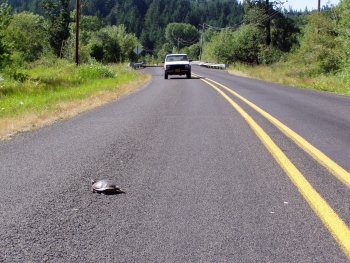 And what should I do with the turtle now that I’ve picked it up and brought it home?
And what should I do with the turtle now that I’ve picked it up and brought it home?
I’m so glad you called!
How can I create habitat for native turtles? I know Oregon’s turtles are in trouble, and I want to help them.
Thank you for asking!
I have turtles on my project site. How can I plan and implement the project without harming them?
I wish more people asked this question!
These are just a few of the turtle-related questions I respond to as the Oregon Department of Fish and Wildlife’s conservation biologist for the west side of the state. My charge is non-game wildlife, meaning species that cannot be hunted or harvested. That’s a lot of species! Eighty-eight percent of them, to be exact.
I get asked a lot of wildlife questions, and sometimes people — usually students, when I come to their classrooms to talk about bats, frogs and other wild critters — ask, “What is your favorite species?” A challenging question for a wildlife biologist, but it doesn’t take long to mentally form my Top 10 List. Making the cut are Oregon’s two native turtle species, the western pond turtle and the western painted turtle.
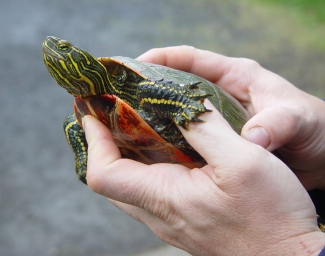 Western pond and western painted turtles are amazing creatures! They spend several months during the winter at the bottom of wetlands, ponds and other water bodies, not eating or even coming up for air. Some turtles spend a lot of time on land, too – up to 10 months! – not eating, as they need to be in water to swallow food.
Western pond and western painted turtles are amazing creatures! They spend several months during the winter at the bottom of wetlands, ponds and other water bodies, not eating or even coming up for air. Some turtles spend a lot of time on land, too – up to 10 months! – not eating, as they need to be in water to swallow food.
They are long-lived, social and curious creatures with strong navigational instincts. When hatchling turtles emerge from their nest chambers in the ground (usually about 6 to 8 inches down), they somehow key into the nearest water source and start their journey of survival. I say nearby, but some female turtles nest over 1,000 feet away from their aquatic habitats. Although turtles do use rivers, sloughs and other waterways to move and disperse, western pond and painted turtles are quite capable of, and do make, long overland treks.
In addition to some pretty fascinating behaviors and habits, our native turtles are also quite beautiful. The pond turtle is olive brown and more uniform in color, while the western painted turtle has bright yellow, orange or red lines on its head, neck and legs. The bottom shell (a.k.a. plastron) of the western painted turtle is spectacular with its unique red-and-black pattern. The western pond turtle has a creamy yellow plastron, often with dark staining.
Both turtle species have experienced significant population declines, and continue to be highly vulnerable to habitat loss and other anthropogenic (human-caused) impacts. As such, they are classified as “Critical” on Oregon’s Sensitive Species List, are “protected non-game wildlife” (OAR 635-044) and cannot be killed, and are priority species in the Oregon Conservation Strategy.
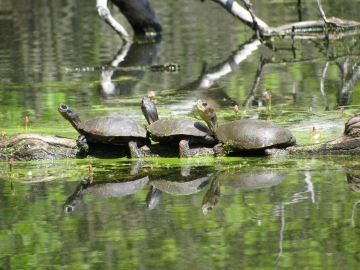 Here in The Intertwine, Smith and Bybee Wetlands Natural Area and the Columbia slough are significant habitats for western painted turtles, with some of the region’s largest known populations. As for western pond turtles, it unfortunately appears that hardly any remain in the Portland area, though some are still hanging on in the Tualatin River basin of Washington County, and a few others have been reported in Clackamas County. You can help by reporting all turtle sightings — especially of western pond turtles, which are under endangered-species status review by the U.S. Fish & Wildlife Service — to www.oregonturtles.com.
Here in The Intertwine, Smith and Bybee Wetlands Natural Area and the Columbia slough are significant habitats for western painted turtles, with some of the region’s largest known populations. As for western pond turtles, it unfortunately appears that hardly any remain in the Portland area, though some are still hanging on in the Tualatin River basin of Washington County, and a few others have been reported in Clackamas County. You can help by reporting all turtle sightings — especially of western pond turtles, which are under endangered-species status review by the U.S. Fish & Wildlife Service — to www.oregonturtles.com.
Population trends and large-scale abundance patterns of western pond and western painted turtles are difficult to measure, but declines in both species are believed to be significant given measurable losses in habitat availability (quantity) and habitat function (quality). Habitat loss is due largely due to the conversion of land for human uses, such as urbanization and agriculture. Habitat degradation is due in part to non-native invasive species, such as reed canary grass.
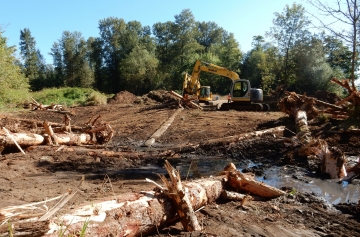 Changes to habitat have occurred throughout Oregon and within the ranges of both turtle species, but are particularly striking in the Willamette Valley. Actions that involve ground disturbance, changes in water level, planting of vegetation, and use of heavy equipment are just a few activities known to negatively affect turtles. Albeit unintentional, these activities can make habitat less suitable for turtles, and even result in direct injury and mortality to turtles present at a project site.
Changes to habitat have occurred throughout Oregon and within the ranges of both turtle species, but are particularly striking in the Willamette Valley. Actions that involve ground disturbance, changes in water level, planting of vegetation, and use of heavy equipment are just a few activities known to negatively affect turtles. Albeit unintentional, these activities can make habitat less suitable for turtles, and even result in direct injury and mortality to turtles present at a project site.
To address a growing demand for proven turtle-helping techniques, ODFW, with input from key turtle conservation partners (collectively known as the Oregon Native Turtle Working Group), recently produced “Guidance for Conserving Oregon’s Native Turtles Including Best Management Practices.” Also referred to as the Turtle BMPs, the document is a compilation of peer-reviewed recommended best methods for creating suitable turtle habitat and for avoiding and minimizing harmful impacts to turtles and their habitats during project implementation, whether it’s culvert replacement, trail construction, dredging, or riparian restoration.
The document also includes an overview of turtle ecology, describes Oregon’s most common non-native invasive turtle species (the red-eared slider and the common snapping turtle), and methods for determining if turtles are present at a particular location or project site. Recommended turtle-habitat assessment tools, survey protocols and data forms are provided, as are recommended plant lists for turtle aquatic and upland habitats.
 The guide includes information on various turtle-related topics (e.g., beavers and turtles, page 64, and chemical contaminants and turtles, page 65), photos of suitable turtle habitat, and sidebars with pithy but succinct answers to common turtle-related questions: “What is aestivation?” (page 16) and “What do turtles eat?” (page 30).
The guide includes information on various turtle-related topics (e.g., beavers and turtles, page 64, and chemical contaminants and turtles, page 65), photos of suitable turtle habitat, and sidebars with pithy but succinct answers to common turtle-related questions: “What is aestivation?” (page 16) and “What do turtles eat?” (page 30).
Which brings me back to the turtle found crossing a road. For a more complete answer see page 63, but in a nutshell, turtles may need to cross roads to get where they want to go. Suitable upland habitats are often disconnected from aquatic habitats by roads, railways, trails or a combination of the three.
While turtles can and do cross roads successfully, roads also kill turtles. How many, we do not know. Regardless, the majority of turtles found crossing roads or hit by a moving vehicle are adult females — big girls on a mission to lay their eggs or on their way back to the water after egg-laying. The loss of a sexually mature female turtle is considered a significant loss to an overall turtle population.
So, as long as it is safe for you to do so, it is reasonable to help a native turtle cross a road by moving it a short distance off the road/shoulder area. The key is to keep the turtle pointed in the same direction it was headed. And do not bring the turtle home!
Everyone can play a role in helping to protect and conserve Oregon’s native turtles. Download your free copy of the Turtle BMPs here.

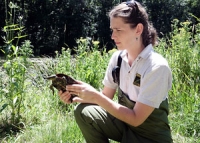 Susan Barnes is the conservation biologist for the Oregon Department of Fish and Wildlife’s West Region. Her focus is conservation of non-game wildlife and their habitats, including those highlighted in the Oregon Conservation Strategy. Her work includes habitat assessment, impact analysis and mitigation planning, and wildlife policy. She never bores of the sometimes bizarre wildlife-related questions she gets from the public!
Susan Barnes is the conservation biologist for the Oregon Department of Fish and Wildlife’s West Region. Her focus is conservation of non-game wildlife and their habitats, including those highlighted in the Oregon Conservation Strategy. Her work includes habitat assessment, impact analysis and mitigation planning, and wildlife policy. She never bores of the sometimes bizarre wildlife-related questions she gets from the public!
Comments
Western Pond Turtle (Actinemys marmorata)
Hi Marvin,
In talking with Susan
Add new comment